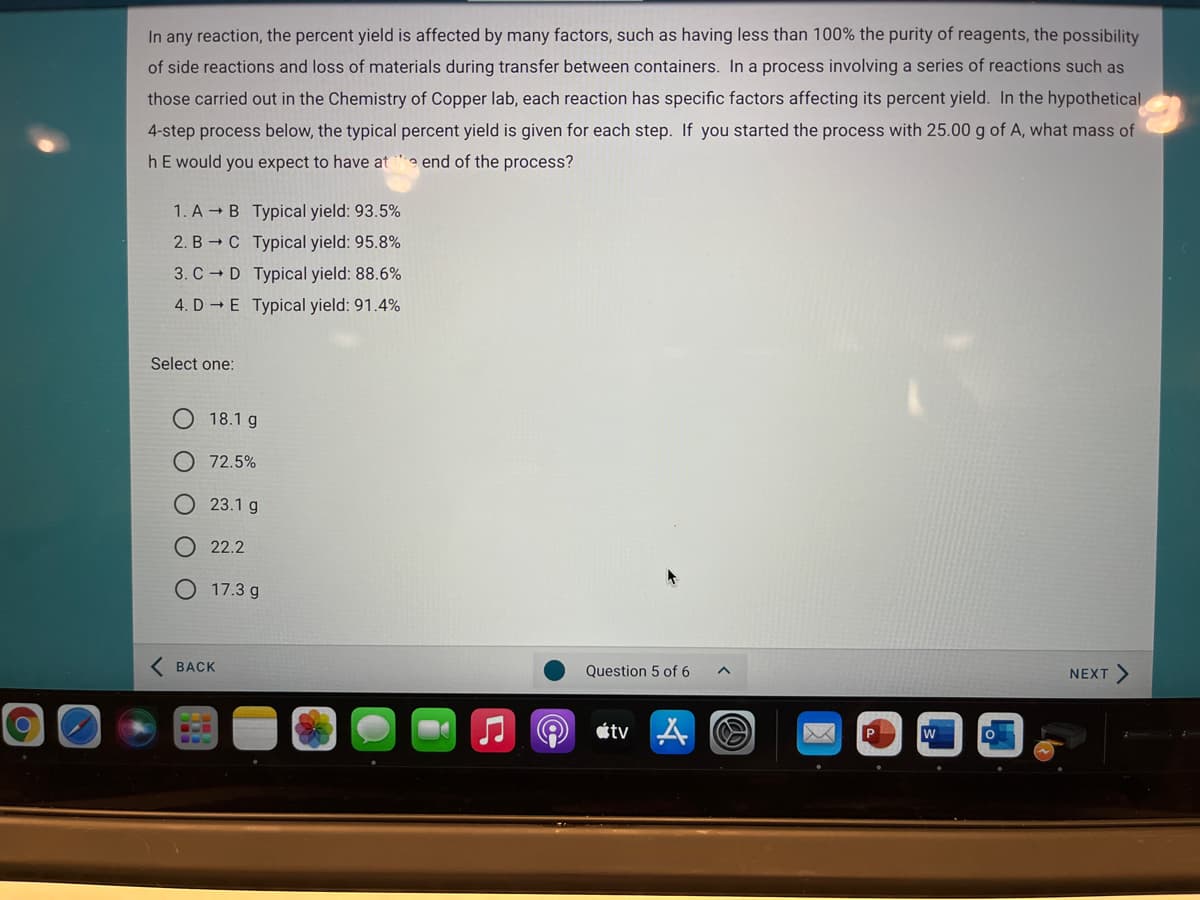In any reaction, the percent yield is affected by many factors, such as having less than 100% the purity of reagents, the possibility of side reactions and loss of materials during transfer between containers. In a process involving a series of reactions such as those carried out in the Chemistry of Copper lab, each reaction has specific factors affecting its percent yield. In the hypothetical 4-step process below, the typical percent yield is given for each step. If you started the process with 25.00 g of A, what mass of hE would you expect to have at e end of the process? 1. A B Typical yield: 93.5% 2. B C Typical yield: 95.8% 3. C D Typical yield: 88.6% 4. D E Typical yield: 91.4% Select one: 18.1 g 72.5% 23.1 g O 22.2 17.3 g
In any reaction, the percent yield is affected by many factors, such as having less than 100% the purity of reagents, the possibility of side reactions and loss of materials during transfer between containers. In a process involving a series of reactions such as those carried out in the Chemistry of Copper lab, each reaction has specific factors affecting its percent yield. In the hypothetical 4-step process below, the typical percent yield is given for each step. If you started the process with 25.00 g of A, what mass of hE would you expect to have at e end of the process? 1. A B Typical yield: 93.5% 2. B C Typical yield: 95.8% 3. C D Typical yield: 88.6% 4. D E Typical yield: 91.4% Select one: 18.1 g 72.5% 23.1 g O 22.2 17.3 g
Introductory Chemistry: An Active Learning Approach
6th Edition
ISBN:9781305079250
Author:Mark S. Cracolice, Ed Peters
Publisher:Mark S. Cracolice, Ed Peters
Chapter10: Quantity Relationships In Chemical Reactions
Section: Chapter Questions
Problem 84E
Related questions
Question
100%

Transcribed Image Text:In any reaction, the percent yield is affected by many factors, such as having less than 100% the purity of reagents, the possibility
of side reactions and loss of materials during transfer between containers. In a process involving a series of reactions such as
those carried out in the Chemistry of Copper lab, each reaction has specific factors affecting its percent yield. In the hypothetical
4-step process below, the typical percent yield is given for each step. If you started the process with 25.00 g of A, what mass of
hE would you expect to have at
e end of the process?
1. A → B Typical yield: 93.5%
2. B → C Typical yield: 95.8%
3. C - D Typical yield: 88.6%
4. D - E Typical yield: 91.4%
Select one:
18.1 g
O 72.5%
O 23.1 g
O 22.2
17.3 g
( BACK
Question 5 of 6
NEXT
étv A O
Expert Solution
This question has been solved!
Explore an expertly crafted, step-by-step solution for a thorough understanding of key concepts.
This is a popular solution!
Trending now
This is a popular solution!
Step by step
Solved in 2 steps

Knowledge Booster
Learn more about
Need a deep-dive on the concept behind this application? Look no further. Learn more about this topic, chemistry and related others by exploring similar questions and additional content below.Recommended textbooks for you

Introductory Chemistry: An Active Learning Approa…
Chemistry
ISBN:
9781305079250
Author:
Mark S. Cracolice, Ed Peters
Publisher:
Cengage Learning

Introductory Chemistry: A Foundation
Chemistry
ISBN:
9781337399425
Author:
Steven S. Zumdahl, Donald J. DeCoste
Publisher:
Cengage Learning

Chemistry: Matter and Change
Chemistry
ISBN:
9780078746376
Author:
Dinah Zike, Laurel Dingrando, Nicholas Hainen, Cheryl Wistrom
Publisher:
Glencoe/McGraw-Hill School Pub Co

Introductory Chemistry: An Active Learning Approa…
Chemistry
ISBN:
9781305079250
Author:
Mark S. Cracolice, Ed Peters
Publisher:
Cengage Learning

Introductory Chemistry: A Foundation
Chemistry
ISBN:
9781337399425
Author:
Steven S. Zumdahl, Donald J. DeCoste
Publisher:
Cengage Learning

Chemistry: Matter and Change
Chemistry
ISBN:
9780078746376
Author:
Dinah Zike, Laurel Dingrando, Nicholas Hainen, Cheryl Wistrom
Publisher:
Glencoe/McGraw-Hill School Pub Co

World of Chemistry
Chemistry
ISBN:
9780618562763
Author:
Steven S. Zumdahl
Publisher:
Houghton Mifflin College Div

World of Chemistry, 3rd edition
Chemistry
ISBN:
9781133109655
Author:
Steven S. Zumdahl, Susan L. Zumdahl, Donald J. DeCoste
Publisher:
Brooks / Cole / Cengage Learning

Chemistry: The Molecular Science
Chemistry
ISBN:
9781285199047
Author:
John W. Moore, Conrad L. Stanitski
Publisher:
Cengage Learning